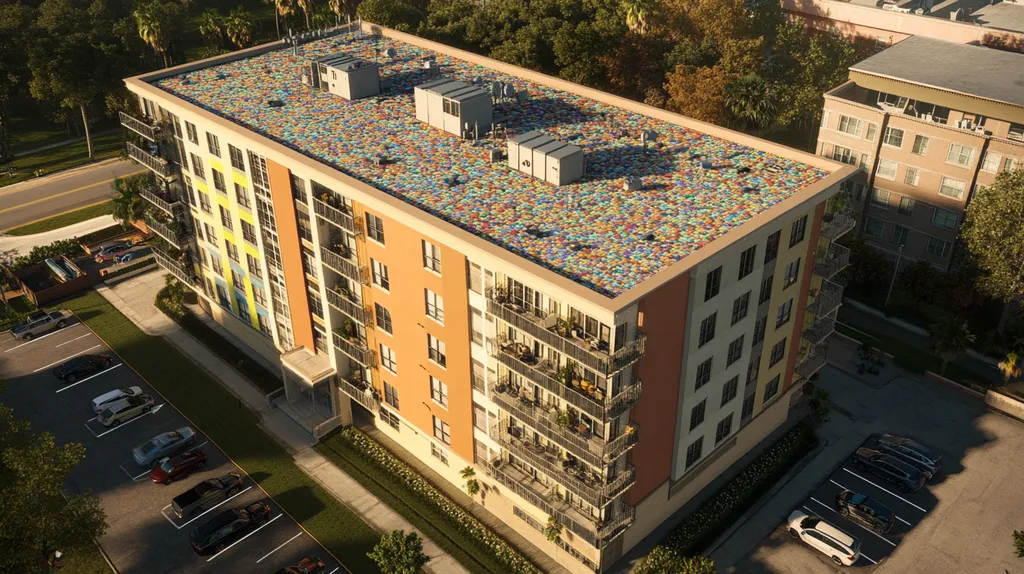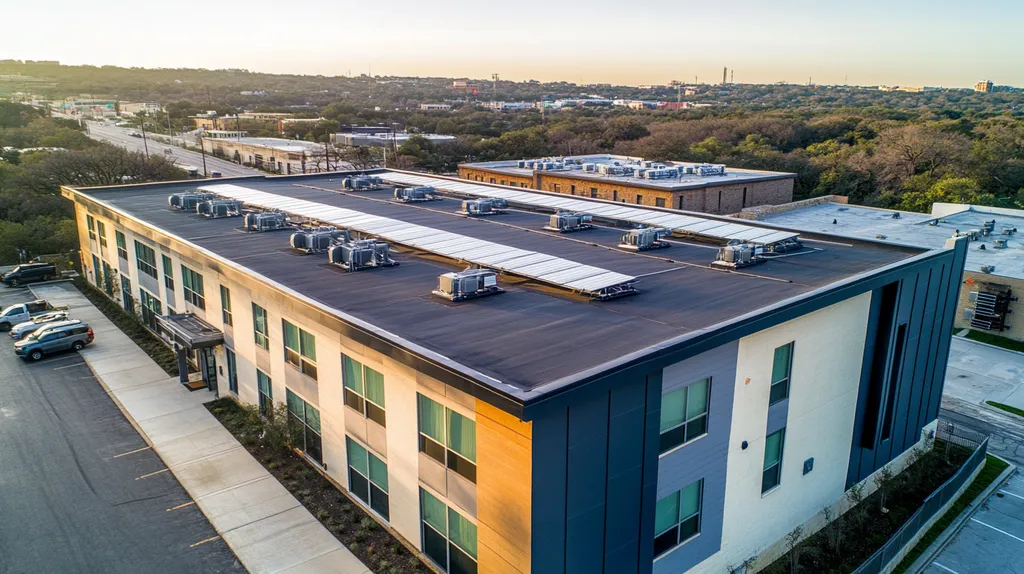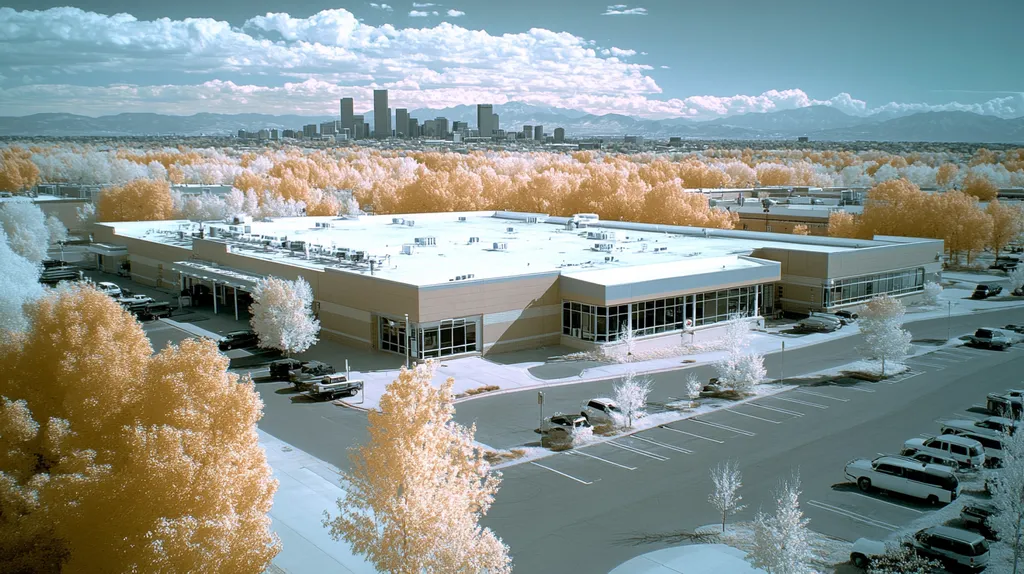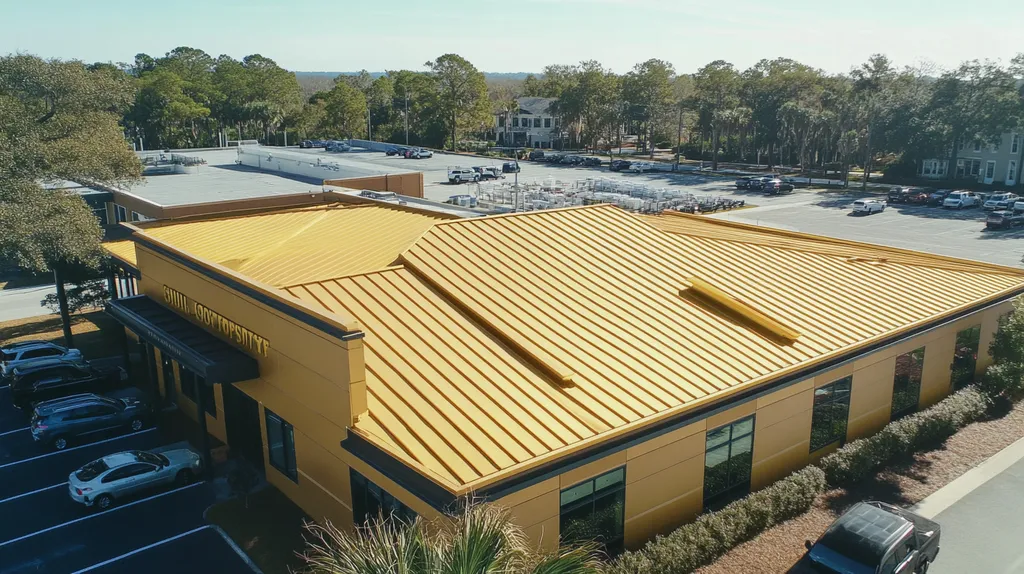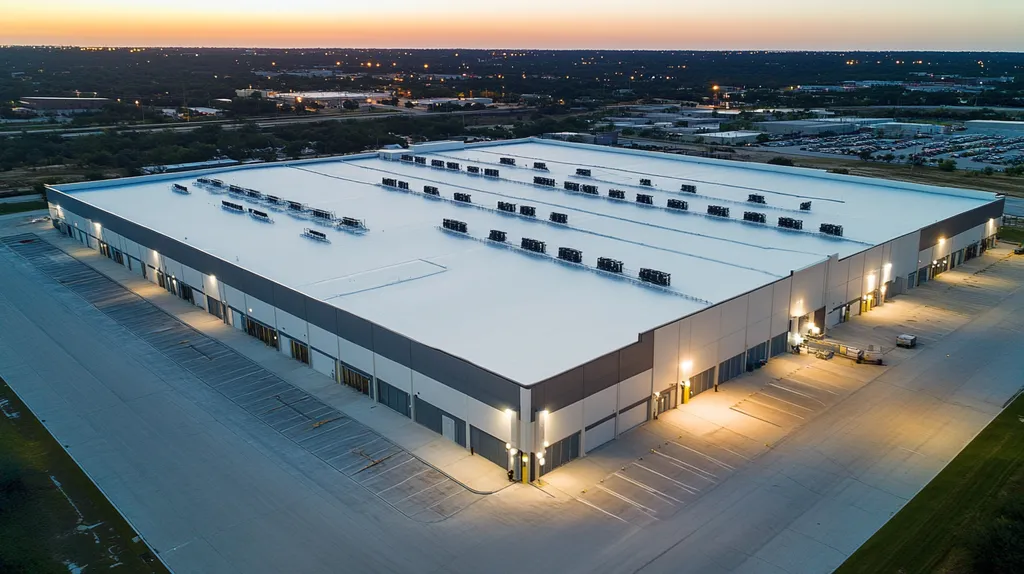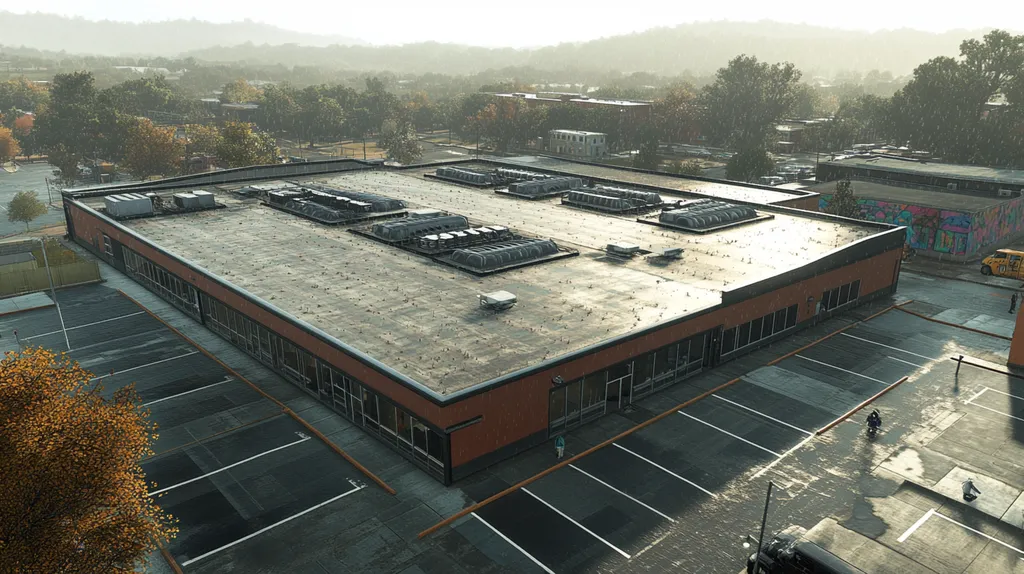Every year, over 15 million tons of commercial roofing materials are torn off and discarded, with nearly 70% ending up in landfills despite being recyclable. This waste costs businesses millions in disposal fees while consuming valuable landfill space.
The roofing industry stands at a critical turning point where recycling decisions made today will impact environmental sustainability for decades to come.
This comprehensive guide examines proven strategies for recycling commercial roofing materials, from initial tear-off procedures through final processing, helping facility managers maximize material recovery while minimizing disposal costs.
SECTION 1: FUNDAMENTAL CONCEPTS
Every year, commercial roofing projects generate over 15 million tons of waste materials – enough to fill nearly 7,000 Olympic-sized swimming pools. Without proper recycling initiatives, these materials consume valuable landfill space and waste resources that could be repurposed. The roofing industry stands at a critical junction where recycling decisions today will impact environmental sustainability for decades to come.
Introduction to Roofing Recycling
Modern roofing recycling transforms what was once considered waste into valuable resources. The process begins during tear-off, where materials are carefully separated and sorted based on composition and recyclability potential.
Low-slope asphalt roofing materials represent one of the most promising recycling opportunities, creating jobs while reducing disposal costs. When properly separated, these materials can be repurposed for paving and other construction applications. (source: Asphalt Roofing Manufacturers Association)
Many facilities now incorporate recycling requirements directly into their roofing specifications. This proactive approach ensures materials are properly handled from the start of each project.
Material Types and Recyclability
Metal roofing components offer the highest recycling potential, with nearly 100% recyclability for steel and aluminum materials. These metals can be processed repeatedly without degrading quality.
Built-up roofing (BUR) systems typically contain multiple recyclable components. The asphalt, gravel, and felts can be separated and processed for various applications including road construction.
Single-ply membranes present unique recycling challenges but are increasingly recyclable. TPO and PVC materials can be ground down and incorporated into new roofing products or walkway pads.
Roof insulation materials vary in recyclability. While some foam products can be reprocessed, others may require specialized handling or alternative disposal methods.
Environmental Benefits Overview
Recycling roofing materials dramatically reduces landfill impact. One typical commercial re-roof project can divert 30-40 tons of material from landfills when proper recycling protocols are followed.
The energy savings from recycling are substantial. Processing recycled metals requires up to 95% less energy compared to mining and refining new materials.
Water conservation represents another key benefit. Manufacturing new roofing materials demands significant water usage, while recycling processes typically require minimal water resources.
Carbon emissions decrease significantly through recycling initiatives. Transportation distances are generally shorter to recycling facilities than landfills, and reprocessing creates fewer emissions than new material production.
SECTION 2: SYSTEM COMPONENTS
Every year, millions of tons of roofing materials reach the end of their service life, presenting both a challenge and an opportunity. Understanding how different roofing components can be recycled is crucial for making environmentally responsible decisions. Proper recycling of these materials not only reduces landfill waste but also creates valuable resources for other industries while potentially reducing project costs.
Asphalt Shingle Recycling Processes
The recycling journey for asphalt shingles begins with careful removal during tear-off operations. Contractors must separate these materials from other roofing components to maintain recycling quality.
Once collected, shingles undergo a specialized grinding process that transforms them into a consistent, granular material. This processed material becomes a valuable component in road construction and new roofing products.
Private paving contractors, hot-mix asphalt producers, and shingle recycling companies have invested millions in equipment and facilities to support this growing industry. Their efforts help divert over 11 million tons of shingles from landfills annually. (source: Asphalt Roofing Manufacturers Association)
Quality control measures ensure the recycled material meets specifications for its intended use. Regular testing confirms the processed shingles maintain consistent properties for various applications.
Metal Roofing Recyclability Features
Metal roofing components offer exceptional recycling value due to their pure material composition. Steel, aluminum, and copper components can be recycled repeatedly without degrading their structural properties.
The recycling process for metal roofing is straightforward, requiring minimal processing compared to other materials. Most metal components can be directly melted down and reformed into new products.
Separating different metal types during demolition maximizes their recycling value. Proper sorting ensures each metal type can be processed efficiently and maintain its highest possible value.
Modern recycling facilities can process virtually any metal roofing component, from panels to fasteners. This comprehensive capability ensures nearly complete material recovery from metal roofing systems.
EPDM and Low-Slope Roofing Components
EPDM membrane recycling requires specialized handling due to its rubber composition. Advanced processing facilities can separate these materials from adhesives and other contaminants.
The recovered EPDM material finds new life in various applications, including playground surfaces and industrial products. This versatility helps create sustainable markets for recycled rubber materials.
Other low-slope components, such as insulation boards and cover boards, present unique recycling challenges. Some facilities can process these materials into new insulation products or alternative uses.
Success in recycling these materials depends heavily on proper removal and handling during tear-off. Contractors must follow specific protocols to maintain material integrity for recycling.
SECTION 3: IMPLEMENTATION METHODS
Commercial roofing projects generate over 8 million tons of recyclable waste annually. Without proper implementation methods, valuable materials end up in landfills while increasing project costs. Successfully recycling these materials requires careful planning across three key areas: specialized tear-off techniques, efficient processing systems, and integration with existing facility operations. The right approach can reduce disposal costs by up to 60% while creating valuable resources for other industries.
Roof Tear-Off and Sorting Techniques
Successful recycling starts with proper tear-off procedures that preserve material integrity. Crews must remove layers systematically, keeping different materials separated from the start rather than mixing them into a single waste stream.
Using dedicated containers for each material type streamlines the sorting process. Metal components, membrane materials, and insulation each require specific handling to maintain their recycling value.
Quality control during tear-off significantly impacts recycling success rates. Crews should remove contaminants like fasteners, adhesives, and non-recyclable materials before they can compromise larger batches of recyclable materials.
Documentation throughout the tear-off process helps track material quantities and types. This data helps measure recycling program effectiveness while providing documentation for sustainability initiatives.
Material Processing and Repurposing
Each roofing material requires specific processing methods to maximize its recycling potential. Asphalt shingles undergo screening through trommel screens and manual sorting to remove contaminants before being ground into three-eighth inch particles, with magnetic separators removing metal components. (source: General Kinematics)
Metal roofing components typically require minimal processing before recycling. These materials can be sorted by type and sent directly to metal recycling facilities for immediate processing.
Single-ply membranes need specialized handling to separate them from adhesives and other attachments. Once cleaned, these materials can be ground into particles for use in new roofing products.
Processing facilities convert many roofing materials into valuable products for other industries. Recycled asphalt shingles become road paving materials, while processed rubber membranes find new life in playground surfaces.
Integration with Existing Infrastructure
Successful recycling programs require coordination between facility managers, contractors, and processing centers. Clear communication channels help ensure materials move efficiently from tear-off to final processing.
Storage areas must be designated for sorted materials awaiting transport. These spaces should protect materials from weather damage while maintaining easy access for loading and transportation.
Transportation logistics play a crucial role in program success. Partnering with local recycling facilities reduces transportation costs while supporting regional sustainability efforts.
Regular program evaluation helps identify opportunities for improvement. Tracking metrics like diversion rates and processing costs allows facilities to optimize their recycling operations over time.
SECTION 4: MAINTENANCE REQUIREMENTS
Effective maintenance strategies dramatically impact both the recyclability and longevity of commercial roofing systems. Poor maintenance practices lead to premature material degradation, forcing early replacement and increasing waste. Without proper oversight, even recyclable materials like PVC membranes can become contaminated or damaged beyond recovery, eliminating their recycling potential and increasing disposal costs.
Regular Inspection and Monitoring
Commercial roofs require systematic inspection protocols to preserve material integrity. Monthly visual assessments help identify developing issues before they compromise recyclable components.
Detailed documentation during inspections creates essential baseline data for tracking material performance. This information guides future recycling decisions and helps optimize maintenance schedules.
Seasonal inspections must focus on areas prone to accelerated wear like drainage points and membrane seams. These vulnerable zones often determine whether materials remain suitable for recycling.
Digital monitoring tools like moisture sensors and thermal imaging now enable continuous roof condition assessment. This technology helps facilities teams intervene before damage becomes severe enough to prevent recycling.
Preventive Measures for Recycling Systems
PVC roofing membranes demonstrate exceptional recycling potential when properly maintained. These materials can be completely reprocessed into new roofing products through specialized grinding facilities, offering a cost-effective alternative to landfill disposal. (source: Roofing Elements Magazine)
Regular cleaning protocols remove debris and contaminants that could compromise recycling potential. Simple measures like quarterly sweeping and drain clearing preserve material quality.
Protective coatings extend service life while maintaining material recyclability. UV-resistant treatments help prevent premature degradation of recyclable components.
Proper drainage maintenance prevents water accumulation that can degrade recyclable materials. Ensuring positive roof slope and clear drain paths preserves both performance and recycling potential.
Addressing Asbestos Exposure Risks
Legacy roofing systems often contain asbestos materials that require specialized handling during maintenance and eventual recycling. Professional testing must precede any work on roofs installed before 1980.
Strict containment protocols protect workers and maintain material separation during maintenance. This segregation ensures hazardous materials don’t contaminate recyclable components.
Documentation of asbestos locations helps maintenance teams avoid disturbing these materials. Clear marking and mapping systems prevent accidental exposure during routine work.
Training programs ensure maintenance staff can identify potential asbestos-containing materials. This knowledge prevents inadvertent exposure and maintains proper material handling procedures.
SECTION 5: PERFORMANCE METRICS
Every year, commercial roofing projects generate massive amounts of recyclable waste that could be diverted from landfills. Effective measurement and tracking of recycling performance allows facility managers to optimize their sustainability efforts while maximizing cost savings. Understanding key metrics around efficiency, economics, and environmental impact helps drive better decision-making in roofing material management.
Measuring Recycling Efficiency Rates
Successful recycling programs require comprehensive tracking systems to measure diversion rates. Digital platforms now enable real-time monitoring of material quantities, types, and final disposition.
Low-slope asphalt roofing materials offer significant recycling potential when properly tracked and separated. Careful monitoring ensures high-value asphalt membrane components are isolated for maximum recycling efficiency and cost savings. (source: Asphalt Roofing Manufacturers Association)
Monthly and quarterly performance reviews help identify areas for improvement. These assessments examine metrics like contamination rates, processing costs, and total diversion percentages.
Benchmarking against industry standards provides context for evaluating program success. Leading facilities typically achieve 75-85% diversion rates through careful tracking and continuous optimization.
Cost Savings and Economic Benefits
Direct cost savings from recycling include reduced landfill fees and lower material disposal expenses. Large commercial projects can save $10,000 or more through effective recycling programs.
Transportation costs decrease when materials go to local recycling facilities rather than distant landfills. Strategic partnerships with nearby processors maximize these logistics savings.
Many recycled materials generate revenue through resale to manufacturers and processors. Clean, well-sorted materials command premium prices in the recycling market.
Tax incentives and sustainability credits provide additional economic benefits. Many jurisdictions offer tax advantages for documented recycling programs.
Environmental Impact Assessment Tools
Life cycle assessment tools measure the full environmental impact of roofing choices. These analyses examine factors from material production through end-of-life disposal.
Carbon footprint calculators quantify emissions reductions from recycling programs. Typical commercial re-roofing projects can prevent 30-40 metric tons of CO2 emissions through recycling.
Water usage tracking demonstrates conservation benefits of recycling versus new material production. Manufacturing virgin materials often requires 10-20 times more water than recycling.
Environmental assessment platforms help facilities demonstrate compliance with sustainability requirements. These tools provide standardized reporting for green building certifications and corporate initiatives.
SECTION 6: OPTIMIZATION STRATEGIES
With over 11 million tons of commercial roofing materials reaching disposal facilities annually, optimizing recycling strategies has become critical for both environmental and financial sustainability. Current industry practices often leave 40-60% of recyclable materials unrecovered, resulting in unnecessary waste and elevated disposal costs. By implementing proven optimization techniques, facilities can dramatically increase material recovery while reducing operational expenses.
Best Practices for Recycling Programs
Low-slope asphalt roof recycling offers significant opportunities for both environmental and economic benefits. These materials can create new jobs at recycling facilities while reducing raw material costs for paving and other construction applications. (source: Asphalt Roofing Manufacturers Association)
Strategic material sorting begins at the planning phase, with clear protocols for separating different components during tear-off. This early organization prevents cross-contamination that could render materials unsuitable for recycling.
Staff training programs must emphasize proper handling techniques and material identification. Regular refresher sessions keep teams updated on evolving recycling requirements and best practices.
Documentation systems track material quantities and types throughout the recycling process. This data enables continuous program optimization while providing evidence for sustainability certifications.
Leveraging Technology for Efficiency
Digital management platforms now enable real-time tracking of material recovery rates and processing status. These systems help identify bottlenecks and optimization opportunities throughout the recycling pipeline.
Automated sorting equipment uses optical and density-based separation to maximize material recovery. This technology significantly increases processing speed while reducing labor costs.
Mobile applications connect field teams with recycling facilities, streamlining logistics and reducing transportation delays. Direct communication channels ensure efficient material handling from roof to recycling center.
Drone-based roof surveys help quantify recyclable materials before project start. This advanced planning optimizes container requirements and processing schedules.
Collaboration with Recycling Facilities
Establishing partnerships with local recycling centers reduces transportation costs while supporting regional sustainability initiatives. These relationships often lead to preferential pricing and dedicated processing capacity.
Regular facility audits ensure processing capabilities align with incoming material streams. This ongoing assessment helps maintain high recovery rates and product quality.
Joint training programs between roofing contractors and recycling facilities improve material handling efficiency. Shared knowledge leads to better preparation and fewer rejected loads.
Feedback loops between facilities and contractors drive continuous improvement in recycling practices. Regular performance reviews identify opportunities to increase recovery rates and reduce processing costs.
Moving Forward
The commercial roofing industry generates over 15 million tons of waste annually, with current recycling programs capturing only 30-40% of recyclable materials.
This massive volume of recoverable resources represents both an environmental imperative and a significant economic opportunity for facility managers.
By implementing comprehensive recycling programs with proper material sorting, efficient processing systems, and strategic partnerships with recycling facilities, organizations can reduce disposal costs by up to 60% while supporting sustainability goals.
The technology, infrastructure, and best practices now exist to dramatically increase recycling rates across the commercial roofing sector – the key lies in taking decisive action to implement these proven solutions.
The future of sustainable commercial roofing depends on the choices facility managers make today regarding material recovery and recycling programs.
FREQUENTLY ASKED QUESTIONS
Q. How much waste do commercial roofing projects generate annually?
A. Commercial roofing projects produce over 15 million tons of waste every year. This waste could fill around 7,000 Olympic-sized swimming pools, highlighting the importance of recycling initiatives.
Q. What types of materials can be recycled from an industrial roof?
A. Asphalt shingles, metal components, and EPDM membranes are commonly recycled materials. Understanding recycling processes for these components can significantly reduce waste and create valuable resources.
Q. How can commercial roof recycling save me costs?
A. Implementing proper recycling methods can reduce disposal costs by up to 60%. Additionally, selling recycled materials may offset project expenses, turning waste into revenue.
Q. What maintenance helps improve recycling potential for commercial roofs?
A. Regular inspections and preventive maintenance preserve materials and extend their lifespan. Cleaning debris and ensuring proper drainage can also maintain recycling potential for roofing systems.
Q. How should I track my roofing material recycling performance?
A. Utilize digital platforms to monitor material quantities, types, and diversion rates. Regular performance reviews can help identify improvement areas and optimize your recycling program.
Q. What technology can enhance recycling in commercial roofing?
A. Digital management platforms and automated sorting equipment can improve efficiency. Additionally, drone surveys help assess roofs before projects start, optimizing recycling logistics and material handling.
Q. How can I ensure compliance with eco-friendly roofing practices?
A. Regular audits and keeping up with local regulations can ensure compliance. Implementing sustainability reporting and documentation also plays a critical role in verifying your eco-friendly practices.

